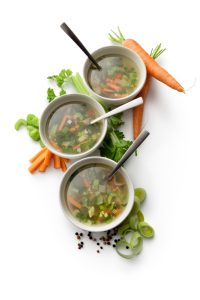Soup it up
As colder days happen more frequently, soups appear on menus, at home and in eateries.

Soups often change seasonally depending on the availability of fresh produce, however certain base ingredients or stocks stay the same. There are seven (at least) types of soups. Usually these are broths, consommes, creamy soups, veloute-based soups, purees, bisques, chowders, and clear soups. Here are some tips on one of them.
Broths
Like stocks, broths are prepared by simmering flavouring ingredients in a liquid over a long period of time. The differences between a broth and stock are that a broth uses meat instead of just bones. The second difference is a finished broth can be served as finished dishes while stocks are used as a base for further cooking. Broths are meant to be flavourful and seasoned.
In a broth-based vegetable soup, such as a minestrone, the vegetables and meats are cooked directly in the broth. Many vegetables have different cooking times, so it is essential to add them at the right time to ensure all ingredients finish cooking at the exact same time.
To create a broth-based vegetable soup follow these steps:
- Sweat long cooking vegetables in butter or fat.
- Add the stock or broth and bring to a simmer.
- Add seasonings such as bay leaves, dried thyme, crushed peppercorns, parsley stems, and garlic in a sachet, allowing enough time for the seasonings to fully flavour the soup.
- Add additional ingredients according to their cooking time.
- Simmer the soup to blend all the flavours.



